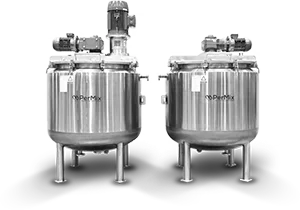Industrial Mixers
PerMix News & Updates



In this blog post, we will delve into the intricacies of mixing tanks and reactors, exploring their similarities and highlighting the key differences between the two. Understanding these differences is essential for various industries, such as chemical engineering, pharmaceuticals, and food processing, where these equipment play a crucial role in the production processes.
Both mixing tanks and reactors serve distinct purposes and have unique functionalities.
A mixing tank, as the name suggests, is primarily used for blending different components or substances. It is designed to facilitate the process of mixing, homogenizing, or emulsifying liquids, powders, or gases. Mixing tanks are commonly employed in industries where consistent blending is necessary, such as in the production of paints, cosmetics, or beverages.
On the other hand, a reactor is a vessel specifically designed for carrying out chemical reactions. It provides a controlled environment for reactions to occur, allowing the desired chemical transformation to take place. Reactors are widely used in industries such as petrochemicals, pharmaceuticals, and polymer manufacturing, where precise control over reaction parameters is critical.
While mixing tanks and reactors may share some similarities in design, there are notable distinctions between them.
Mixing tanks are typically cylindrical or rectangular containers made of stainless steel, plastic, or other durable materials. They feature various components like agitators, baffles, and spargers to facilitate efficient mixing. The design of a mixing tank focuses on optimizing the blending process, ensuring thorough and consistent mixing of the ingredients.
Reactors, on the other hand, are designed with the specific chemical reaction in mind. They come in various types, including batch reactors, continuous flow reactors, and stirred tank reactors. Reactors are constructed to withstand the harsh conditions of chemical reactions, often requiring materials that can resist high temperatures, pressure, and corrosive substances.
The operating conditions for mixing tanks and reactors differ based on their intended applications.
Mixing tanks generally operate at ambient or slightly elevated temperatures and atmospheric pressure. The focus is on achieving proper mixing and maintaining the desired consistency of the mixture. Temperature and pressure control are not typically critical factors in mixing tank operations.
Reactors, on the other hand, operate under carefully controlled conditions to ensure the desired chemical reaction occurs. These conditions can vary significantly depending on the specific reaction, including temperature, pressure, pH level, and the presence of catalysts. Reactors often require precise control and monitoring of these parameters to achieve the desired reaction outcome.
Safety considerations play a crucial role in the design and operation of both mixing tanks and reactors.
In mixing tanks, safety considerations mainly revolve around the prevention of spills, leaks, or cross-contamination. Proper sealing mechanisms, robust construction materials, and appropriate safety features are implemented to minimize risks during mixing operations.
Reactor safety, on the other hand, extends beyond containment measures. Since reactors involve chemical reactions, additional safety measures are implemented to prevent hazards such as thermal runaway, pressure build-up, or release of toxic gases. Specialized safety systems, emergency relief mechanisms, and careful process control are typically employed to ensure the safety of personnel and the surrounding environment.
The scale and production capacity of mixing tanks and reactors vary depending on the industry and specific applications.
Mixing tanks are available in a wide range of sizes, from small laboratory-scale vessels to large industrial tanks capable of holding thousands of gallons. The production capacity depends on factors such as the viscosity of the mixture, blending time, and the desired output volume.
Reactors, on the other hand, can vary significantly in size and production capacity based on the scale of the chemical reaction. They can range from small benchtop reactors used in research laboratories to large-scale industrial reactors capable of producing tons of product per day.
In summary, while mixing tanks and reactors have some similarities in terms of their design and functionality, they serve distinct purposes and have different operating conditions. Understanding the differences between these two equipment types is crucial for selecting the right equipment for specific applications in various industries and PerMix understands this. Come see the PerMix difference by visiting us at www.permixmixers.com
#permix #tanks #reactors #Foodmanufacturing #pharmaceuticalmanufacturing #chemicalmanufacturing







